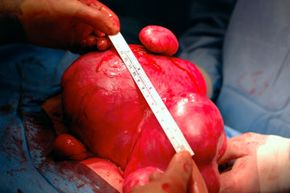Fibroids, also called uterine leiomyomata, are round (or semi-round), benign tumors that grow in the smooth muscle of a woman's uterus. If it sounds painful, that's because it can be.
Uterine fibroids are one of the most common causes of abnormal uterine bleeding, but the reason why some women develop fibroids is unclear.
Advertisement
Age is a factor. Fibroids tend to affect women over the age of 35, and as many as 20 to 40 percent of women over the age of 35 have or have had uterine fibroids. African American women seem to be at a higher risk of developing fibroids -- as many as 50 percent of black women who have yet to go through menopause are affected. Although it's less frequent for women in their 20s to have fibroids, it's still possible, and it's estimated that about 30 percent of women between the ages of 25 and 45 develop fibroids [sources: Puscheck, USAHRQ].
Family history and, as we just mentioned, ethnicity do appear play a role -- African American women are two to three times more likely to have fibroids, although the reason they are more susceptible remains unclear [source: Stöppler]. Fibroids do seem to be associated with increases in estrogen levels in the body, often rapidly growing during early pregnancy, when estrogen levels are rapidly rising, as well as in women who take oral contraception, and typically shrinking after a woman enters menopause and her estrogen levels decline.
Not all fibroids are the same, and they're classified based on where they're located: Submucosal fibroids grow inside the uterus, while subserosal fibroids grow on the outside of the uterus. Fibroids that grow inside the muscular uterine wall are called intramural fibroids [source: GUH - DVIR].
How do you know if you have fibroids? We'll talk about the symptoms of the menstrual disorder, next.
Advertisement
